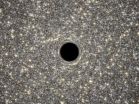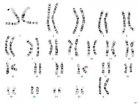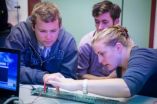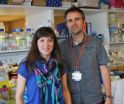(Press-News.org) Astronomers using the NASA/ESA Hubble Space Telescope have found a monster lurking in a very unlikely place. New observations of the ultracompact dwarf galaxy M60-UCD1 have revealed a supermassive black hole at its heart, making this tiny galaxy the smallest ever found to host a supermassive black hole. This suggests that there may be many more supermassive black holes that we have missed, and tells us more about the formation of these incredibly dense galaxies. The results will be published in the journal Nature on 18 September 2014.
Lying about 50 million light-years away, M60-UCD1 is a tiny galaxy with a diameter of 300 light-years -- just 1/500th of the diameter of the Milky Way. Despite its size it is pretty crowded, containing some 140 million stars. While this is characteristic of an ultracompact dwarf galaxy (UCD) like M60-UCD1, this particular UCD happens to be the densest ever seen [1].
Despite their huge numbers of stars, UCDs always seem to be heavier than they should be. Now, an international team of astronomers has made a new discovery that may explain why -- at the heart of M60-UCD1 lurks a supermassive black hole [2] with the mass of 20 million Suns.
"We've known for some time that many UCDs are a bit overweight. They just appear to be too heavy for the luminosity of their stars," says co-author Steffen Mieske of the European Southern Observatory in Chile. "We had already published a study that suggested this additional weight could come from the presence of supermassive black holes, but it was only a theory. Now, by studying the movement of the stars within M60-UCD1, we have detected the effects of such a black hole at its centre. This is a very exciting result and we want to know how many more UCDs may harbour such extremely massive objects."
The supermassive black hole at the centre of M60-UCD1 makes up a huge 15 percent of the galaxy's total mass, and weighs five times that of the black hole at the centre of the Milky Way. "That is pretty amazing, given that the Milky Way is 500 times larger and more than 1000 times heavier than M60-UCD1," explains Anil Seth of the University of Utah, USA, lead author of the international study. "In fact, even though the black hole at the centre of our Milky Way galaxy has the mass of 4 million Suns it is still less than 0.01 percent of the Milky Way's total mass, which makes you realise how significant M60-UCD1's black hole really is."
The team discovered the supermassive black hole by observing M60-UCD1 with both the NASA/ESA Hubble Space Telescope and the Gemini North 8-metre optical and infrared telescope on Hawaii's Mauna Kea, USA. The sharp Hubble images provided information about the galaxy's diameter and stellar density, whilst Gemini was used to measure the movement of stars in the galaxy as they were affected by the black hole's gravitational pull. These data were then used to calculate the mass of the unseen black hole.
The finding implies that there may be a substantial population of previously unnoticed black holes. In fact, the astronomers predict there may be as many as double the known number of black holes in the local Universe.
Additionally, the results could affect theories of how such UCDs form. "This finding suggests that dwarf galaxies may actually be the stripped remnants of larger galaxies that were torn apart during collisions with other galaxies, rather than small islands of stars born in isolation," explains Seth. "We don't know of any other way you could make a black hole so big in an object this small."
One explanation is that M60-UCD1 was once a large galaxy containing 10 billion stars, and a supermassive black hole to match. "This galaxy may have passed too close to the centre of its much larger neighbouring galaxy, Messier 60," explains co author Remco van den Bosch of the Max Planck Institute for Astronomy in Heidelberg, Germany. "In that process the outer part of the galaxy would have been torn away to become part of Messier 60, leaving behind only the small and compact galaxy we see today."
The team believes that M60-UDC1 may one day merge with Messier 60 to form a single galaxy. Messier 60 also has its own monster black hole an amazing 4.5 billion times the size of our Sun and more than 1000 times bigger than the black hole in our Milky Way. A merger between the two galaxies would also cause the black holes to merge, creating an even more monstrous black hole.
INFORMATION:
Notes
[1] In fact, if you lived inside this galaxy the night sky would dazzle with the light of at least a million stars, all visible to the naked eye. On Earth, a comparatively measly 4000 stars are visible.
[2] Black holes are ultracompact objects with a gravitational pull so strong that even light cannot escape. Supermassive black holes -- those with the mass of at least 1 million stars like our Sun -- are thought to be at the centres of many galaxies.
Notes for editors
The Hubble Space Telescope is a project of international cooperation between ESA and NASA.
The international team of astronomers in this study consists of A.C. Seth (University of Utah, USA); R. van den Bosch (Max Planck Institute for Astronomy, Heidelberg, Germany); S. Mieske (European Southern Observatory, Chile); H. Baumgardt (University of Queensland, Australia); M. den Brok (University of Utah, USA); J. Strader (Michigan State University, USA); N. Neumayer (European Southern Observatory, Germany); I. Chilingarian (Smithsonian Astrophysical Observatory, USA; Moscow State University, Russia); M. Hilker (European Southern Observatory, Germany); R. McDermid (Australian Astronomical Observatory, Australia; Macquarie University, Australia); L. Spitler (Australian Astronomical Observatory, Australia; Macquarie University, Australia); J. Brodie (University of California, USA); M. J. Frank (Heidelberg University, Germany); J. L. Walsh (The University of Texas at Austin, USA).
More information
Image credit: NASA, ESA, D. Coe, G. Bacon (STScI)
Links
Images of Hubble - http://www.spacetelescope.org/images/archive/category/spacecraft/
NASA press release - http://hubblesite.org/newscenter/archive/releases/2014/41
Science paper in Nature - http://dx.doi.org/10.1038/nature13762
Contacts
Anil Seth
University of Utah
Salt Lake City, Utah, USA
Tel: +1-801-585-7793
Cell: +1-206-724-3820
Email: aseth@astro.utah.edu
Remco van den Bosch
Max Planck Institute for Astronomy
Heidelberg, Germany
Tel: +1-702-337-9424 (currently travelling in USA)
Email: bosch@mpia.de
Georgia Bladon
ESA/Hubble, Public Information Officer
Garching bei München, Germany
Tel: +44 7816291261
Email: gbladon@partner.eso.org
Big surprises can come in small packages
Hubble helps astronomers find smallest known galaxy with supermassive black hole
2014-09-17
ELSE PRESS RELEASES FROM THIS DATE:
A link between Jacobsen syndrome and autism
2014-09-17
SAN DIEGO, Calif. (Sept. 17, 2014)— A rare genetic disorder known as Jacobsen syndrome has been linked with autism, according to a recent joint investigation by researchers at San Diego State University and the University of California, San Diego. In addition to suggesting better treatment options for people with Jacobsen syndrome, the finding also offers more clues into the genetic underpinnings of autism.
Jacobsen syndrome affects approximately 1 in 100,000 people, according to the National Institutes of Health. It occurs in a person when there is a deletion at the end ...
Lack of facial expression leads to perceptions of unhappiness, new OSU research shows
2014-09-17
CORVALLIS, Ore. – People with facial paralysis are perceived as being less happy simply because they can't communicate in the universal language of facial expression, a new study from an Oregon State University psychology professor shows.
The findings highlight the important role the face plays in everyday communication and indicates people may hold a prejudice against those with facial paralysis because of their disability, said Kathleen Bogart, an assistant professor of psychology in the College of Liberal Arts at Oregon State University.
"People are more wary and ...
Entrepreneurs aren't overconfident gamblers
2014-09-17
Leaving one's job to become an entrepreneur is inarguably risky. But it may not be the fear of risk that makes entrepreneurs more determined to succeed. A new study finds entrepreneurs are also concerned about what they might lose in the transition from steady employment to startup.
In Entrepreneurship and Loss-Aversion in a Winner-Take-All Society, Professor John Morgan at UC Berkeley's Haas School of Business and co-author Dana Sisak, assistant professor at the Erasmus University Rotterdam, focused on the powerful impact of loss aversion.
Loss aversion, or the fear ...
Oxides discovered by CCNY team could advance memory devices
2014-09-17
The quest for the ultimate memory device for computing may have just taken an encouraging step forward. Researchers at The City College of New York led by chemist Stephen O'Brien have discovered new complex oxides that exhibit both magnetic and ferroelectric properties.
Combining both properties is very exciting scientifically for the coupling that can occur between them and for the devices that might ultimately be designed, in logic circuits or spintronics. Combining these two properties in a single material, however, has proved difficult until now.
Using an innovative ...
Engineers develop algorithms to switch out and recharge battery modules in electric cars
2014-09-17
Imagine being able to switch out the batteries in electric cars just like you switch out batteries in a photo camera or flashlight. A team of engineers at the University of California, San Diego, are trying to accomplish just that, in partnership with a local San Diego engineering company.
They have developed smaller units within the battery, called modules, and a battery management system that will allow them to swap out and recharge the modules, rather than swapping out the whole battery, which is cumbersome and requires large, heavy equipment. They recently presented ...
US health system not properly designed to meet needs of patients nearing end of life, says IOM
2014-09-17
WASHINGTON -- The U.S. health care system is not properly designed to meet the needs of patients nearing the end of life and those of their families, and major changes to the system are necessary, says a new report from the Institute of Medicine. The 21-member committee that wrote the report envisioned an approach to end-of-life care that integrates traditional medical care and social services and that is high-quality, affordable, and sustainable. The committee called for more "advance care planning" for end-of-life by individuals, for improved training and credentialing ...
First blood test to diagnose depression in adults
2014-09-17
CHICAGO --- The first blood test to diagnose major depression in adults has been developed by Northwestern Medicine® scientists, a breakthrough approach that provides the first objective, scientific diagnosis for depression. The test identifies depression by measuring the levels of nine RNA blood markers. RNA molecules are the messengers that interpret the DNA genetic code and carry out its instructions.
The blood test also predicts who will benefit from cognitive behavioral therapy based on the behavior of some of the markers. This will provide the opportunity for more ...
Many throat cancer patients can skip neck surgery
2014-09-17
A new study shows that patients with human papillomavirus (HPV) – the same virus associated with both cervical and head and neck cancer – positive oropharyngeal cancer see significantly higher rates of complete response on a post-radiation neck dissection than those with HPV-negative oropharyngeal cancer. Fox Chase Cancer Center researchers presented the findings at the American Society for Radiation Oncology's 56th Annual Meeting on Wednesday, September 17.
"For patients that achieve a complete response, neck surgery is probably unnecessary," says Thomas J. Galloway, ...
Five genes to predict colorectal cancer relapses
2014-09-17
Researchers at the Catalan Institute of Oncology-Bellvitge Biomedical Research Institute (ICO-IDIBELL), led by David Garcia-Molleví have identified 5 genes differentially expressed in normal accompanying cells in colorectal tumors. Analysis of these genes could be used to classify colorectal tumors, predict the evolution of the patient and thus take appropriate clinical decisions to prevent relapses.
Biomarkers
Colorectal cancer is the most common in our population considering both sexes. About 30,000 new cases are diagnosed each year. Of these, approximately 70% are ...
Abnormal properties of cancer protein revealed in fly eyes
2014-09-17
EAST LANSING, Mich. – Mutations in the human retinoblastoma protein gene are a leading cause of eye cancer. Now, Michigan State University scientists have turned to fruit fly eyes to unlock the secrets of this important cancer gene.
In a paper featured on the cover of the current issue of the Journal of Biological Chemistry, Michigan State University researchers provide the first detailed examination of a set of mutations similar to those present in the human cancer gene, said Irina Pushel, MSU undergraduate and co-author.
"By systematically evaluating mutations of ...
LAST 30 PRESS RELEASES:
Revealing the diversity of olfactory receptors in hagfish and its implications for early vertebrate evolution
Development of an ultrasonic sensor capable of cuffless, non-invasive blood pressure measurement
Longer treatment with medications for opioid use disorder is associated with greater probability of survival
Strategy over morality can help conservation campaigns reduce ivory demand, research shows
Rising temperatures reshape microbial carbon cycling during animal carcass decomposition in water
Achieving ultra-low-power explosive jumps via locust bio-hybrid muscle actuators
Plant-derived phenolic acids revive the power of tetracycline against drug-resistant bacteria
Cooperation: A costly affair in bacterial social behaviour?
Viruses in wastewater: Silent drivers of pollution removal and antibiotic resistance
Sub-iethal water disinfection may accelerate the spread of antibiotic resistance
Three in four new Australian moms struggle with body image
Post-stroke injection protects the brain in preclinical study
Cardiovascular risk score predicts multiple eye diseases
Health: estimated one in ten British adults used or interested in GLP-1 medications for weight loss
Exercise to treat depression yields similar results to therapy
Whooping cough vaccination for pregnant women strengthens babies’ immune system
Dramatic decline in new cases of orphanhood in Uganda driven by HIV treatment and prevention programs
Stopping weight loss drugs linked to weight regain and reversal of heart health markers
Higher intake of food preservatives linked to increased cancer risk
Mass General Brigham–developed cholera vaccine completes phase 1 trial
First experimental validation of a “150-year-old chemical common sense” direct visualization of the molecular structural changes in the ultrafast anthracene [4+4] photocycloaddition reaction
Lack of support for people on weight loss drugs leaves them vulnerable to nutritional deficiencies, say experts
Dogs’ dinners can have greater climate impact than owners’
Are you ready to swap salmon for sprats and sardines?
1.6 million UK adults used weight loss drugs in past year
American College of Cardiology comments on new dietary guidelines for Americans
American Society of Gene & Cell Therapy and Orphan Therapeutics Accelerator partner to advance and commercialize promising rare disease treatments
One in 14 patients having day case surgery have new or worse chronic pain 3 months after their operation
New study highlights link between eviction rates and gun violence
Heatwaves heat up soil but not toxin levels in rice, study finds
[Press-News.org] Big surprises can come in small packagesHubble helps astronomers find smallest known galaxy with supermassive black hole






